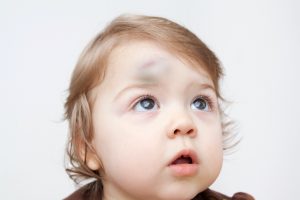 Since toddlers are curious little creatures testing out new motor skills, even with the best babyproofing and a watchful eye, chances are they may fall down and bump their heads. And while the experts say that the majority of head injuries in toddlers are minor, these accidents can still rattle parents and caregivers.
Since toddlers are curious little creatures testing out new motor skills, even with the best babyproofing and a watchful eye, chances are they may fall down and bump their heads. And while the experts say that the majority of head injuries in toddlers are minor, these accidents can still rattle parents and caregivers.
Let’s take a closer look at why toddlers are prone to head injuries and what the signs of a serious head injury look like.
Highlights:
|
Head Injuries are More Common in Young Children
It’s important to note how common head injuries are in toddlers when compared to adults. Accidents that lead to those boo-boos and bruises on the head happen more often in toddlers for a few key reasons. As we mentioned in the introduction, toddlers are more likely to experience a fall because they’re still learning to master movements like walking, kicking, or jumping. In addition, the proportion of their bodies at this stage of development doesn’t exactly work in their favor. Their heads are disproportionately larger than their bodies, which makes them more difficult to control. And since their center of gravity is located more towards their head, it tends to be the body part that endures the most injuries. As toddlers get taller and the muscles in their legs, trunk, and neck develop, head injuries won’t be as common.
Even though it’s natural for toddlers to frequently bump their heads, it’s still important to do everything possible to try to prevent it. For instance, dangerous areas of the home, such as staircases, should always be secured with babyproof equipment. Helmets should be worn when learning to ride tricycles or balance bikes. When playing at the playground or doing other activities that involve a lot of movement, toddlers need to be supervised. While you can’t avoid all the falls, taking proper safety precautions can help protect those little noggins.
Signs of Serious Head Injuries
Most toddler head injuries can be treated at home with an ice pack, band-aid, and some extra love and care. However, it’s important to be aware of signs that point to something more serious, like a concussion or a need for stitches. These situations require a trip to the emergency room to make sure that their injuries are treated quickly and with the right medical equipment. Remember that signs of a concussion can appear within 24-48 hours after an accident.
If you notice any of these signs or symptoms, call an ambulance or bring your child to the emergency room as soon as possible:
- A cut that’s led to uncontrollable bleeding. (Keep in mind that even minor cuts on the head, face, or scalp can bleed heavily because of the many blood vessels close to the surface. But if the bleeding doesn’t stop after attempting to treat it at home, stitches may be necessary.)
- A loss of consciousness or if they’re unresponsive
- Vomiting (more than once after the accident)
- Trouble breathing
- Blood draining from the nose or ears
- A loss of memory
- Bruising around the eyes or behind the ears
- Seizures
- Pupils appear to be different sizes
- Excessive swelling
- Soft spot on the skull
- Major changes in their mood or behavior (e.g. more irritable or extreme fatigue)
Even if you don’t see any of these signs, but your parental instinct urges a trip to the ER, it’s perfectly okay to be extra careful and get the reassurance and support you need from a medical professional. It’s always recommended to contact a doctor if you’re unsure of the severity of your child’s head injury.
Back







